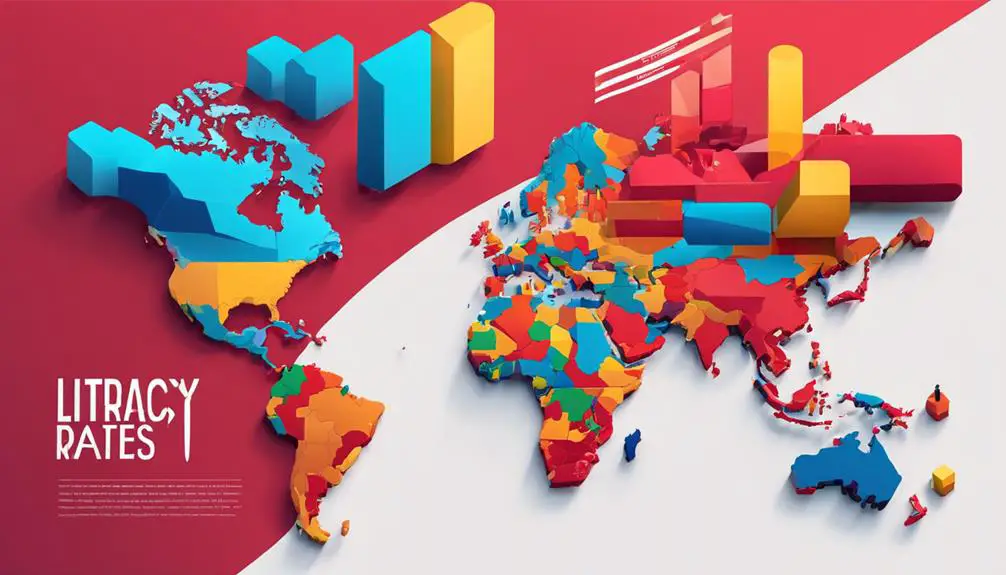The statistics pertaining to education in Afghanistan paint a nuanced picture of progress and persistent challenges. The increase in school enrollment is a positive indicator, yet the stark reality of millions of children, particularly girls, being out of school raises concerns.
Additionally, the low literacy rate among adults underscores the need for comprehensive educational reform. As we delve into the intricacies of education in Afghanistan, it becomes evident that behind the numbers lie complex societal barriers and systemic issues that demand further examination and thoughtful consideration.
Key Takeaways
- Gross primary school enrollment in Afghanistan exceeded 100% in 2019.
- Gender disparities in literacy rates persist, particularly affecting women.
- Challenges in girls' education necessitate targeted interventions.
- Efforts to improve education infrastructure and access are ongoing.
Enrollment Rates
Highlighting the educational landscape in Afghanistan, the enrollment rates showcase a contrast between primary and secondary school participation. In 2019, gross primary school enrollment in Afghanistan exceeded 100%, indicating over-enrollment in primary schools. This suggests a strong initial interest and access to primary education among Afghan children. However, the transition to secondary education presents a different scenario, with only 55% of children enrolled in secondary schools. The significant drop in enrollment from primary to secondary school indicates challenges in retaining students in the education system beyond the primary level.
Various factors contribute to the lower secondary school enrollment rates in Afghanistan, including socio-economic barriers and cultural norms that may prioritize boys' education over girls'. Addressing these barriers is crucial to improving overall enrollment rates and ensuring that all children have access to quality education. By focusing on increasing access to and promoting the value of secondary education, Afghanistan can work towards a more balanced and inclusive educational system that supports the development and growth of its youth population.
Literacy Levels
With an adult literacy rate of approximately 37% in 2021, Afghanistan faces challenges in fostering widespread literacy among its population. Despite efforts to improve education, the country still lags behind in literacy levels compared to other low-income nations.
Some key points to consider include:
- The youth literacy rate for males aged 15-24 is 61.9%, significantly higher than the rate for females in the same age group, which stands at 29.9%.
- Less than 2 in ten women aged 15-49 are literate in Afghanistan, highlighting a stark gender disparity in literacy levels.
- The overall literacy rate in Afghanistan is below the average for countries with similar income levels, indicating a need for targeted interventions to enhance literacy.
- Efforts to improve literacy should address the significant gender gap, ensuring that both males and females have equal opportunities to access quality education.
- Developing comprehensive literacy programs tailored to the needs of different demographics is crucial for enhancing overall literacy rates in Afghanistan.
Gender Disparities
Gender disparities in education in Afghanistan are stark, with significantly lower literacy rates among females compared to males. This imbalance is evident in both youth and adult literacy rates, highlighting the challenges faced by women in accessing educational opportunities.
Addressing the male-female enrollment rates and enhancing educational opportunities for girls are crucial steps towards narrowing this gender gap in literacy rates.
Male-Female Enrollment Rates
In Afghanistan, the enrollment rates for males and females exhibit significant disparities, particularly in terms of access to education. These differences are evident in various literacy rates between genders, highlighting the educational challenges faced by women in the country. The disparities in male-female enrollment rates are concerning, as they indicate a lack of equal opportunities for education.
- The youth literacy rate for males aged 15-24 is 61.9%, while for females it is significantly lower at 29.9%.
- Less than 2 in ten women aged 15-49 in Afghanistan are literate.
- Female literacy rates in the country are lower than the average for low-income nations.
- The literacy rate for males aged 15-24 is much higher at 61.9% compared to females at 29.9%.
- Data from EPDC emphasizes the substantial gender disparity in literacy rates, underscoring the need for targeted efforts to improve female education access.
Educational Opportunities for Girls
Despite the strides made in addressing educational disparities, the challenges hindering girls' access to education in Afghanistan remain substantial. Only 29.9% of females aged 15-24 are literate, contrasting with 61.9% of males. In 2004, 60% of school-aged girls were out of school due to factors like insecurity, distance to schools, lack of female teachers, and early marriage.
Home-Based Schooling (HBS) has helped marginalized girls, with almost 60% of students enrolled in 2003 being girls. Gender disparities persist, with less than 2 in ten women aged 15-49 being literate. Efforts must continue to overcome these obstacles and provide equal educational opportunities for girls in Afghanistan to ensure their empowerment and contribution to the nation's development.
Education Infrastructure
The educational infrastructure in Afghanistan, characterized by a network of over 15,000 general education schools, plays a crucial role in serving nearly 8.7 million students across the country. This infrastructure forms the backbone of the education system, striving to provide learning opportunities to a significant portion of the population. Despite its importance, challenges such as poverty, inadequate facilities, and a lack of qualified teachers hinder the effectiveness of this infrastructure.
- The presence of over 15,000 general education schools
- Serving almost 8.7 million students nationwide
- Varied levels of infrastructure quality across different regions
- Insufficient facilities and resources in many schools
- Ongoing efforts to improve infrastructure and address these challenges
Efforts to enhance the education infrastructure are essential to ensure that all students have access to quality education. Addressing issues like inadequate facilities and resource shortages is crucial in creating a conducive learning environment for the youth of Afghanistan.
Quality of Education
Efforts to enhance the educational infrastructure in Afghanistan are closely intertwined with addressing the quality of education, a critical aspect reflected in completion rates, enrolment ratios, and government expenditure on secondary education.
The completion rate for primary education stands at 65.2% for both sexes, indicating a significant portion of students successfully finishing this level. However, the gross enrolment ratio for secondary education is 55.43%, highlighting a gap between primary and secondary education participation.
Alarmingly, government expenditure on secondary education is a mere 0.01% of GDP, potentially impacting the quality of education at this level. Furthermore, the total net enrolment rate for upper secondary education is 44.1% for both sexes, indicating further challenges in progressing to higher levels of education.
The completion rate for lower secondary education, with an adjusted gender parity index of 0.62, points towards disparities in educational opportunities based on gender, further emphasizing the need to improve the quality of education in Afghanistan.
Challenges Faced
Struggling against numerous obstacles, the education system in Afghanistan grapples with significant challenges impacting access and quality of education for its youth. Despite efforts to improve, the following hurdles persist:
- High Number of Out-of-School Children: Approximately 3.7 million children are out of school in Afghanistan, with a majority being girls.
- Barriers to Girls' Education: Factors such as insecurity, traditional norms, lack of female teachers, and early marriage significantly hinder girls' access to education.
- Low Completion Rates: Many children in Afghanistan still struggle to complete primary school, highlighting a gap in educational attainment.
- Disparities in Enrolment: Enrolment levels vary significantly across regions, with the poorest and most remote areas facing the greatest challenges in accessing education.
- Impact of Conflict: The prolonged conflict in Afghanistan has devastated the education system, further exacerbating the barriers to learning for many children.
These challenges underscore the urgent need for targeted interventions to address the systemic issues impeding educational progress in Afghanistan.
Opportunities for Improvement
Amidst the challenges facing education in Afghanistan, avenues for enhancement and progress emerge through targeted interventions and collaborative initiatives. One significant opportunity lies in addressing the substantial gender disparity in literacy rates within the country. By focusing on enhancing access to quality education for girls, Afghanistan can work towards narrowing the education gap.
Implementing female-specific education programs is essential in empowering Afghan girls and improving overall education outcomes. Collaborative efforts involving the public sector and NGOs play a crucial role in overcoming the obstacles that hinder female education in Afghanistan.
Home-Based Schooling (HBS) has emerged as an effective approach in reaching marginalized girls and boosting literacy rates among females in the country. Through strategic interventions that prioritize gender equality and inclusive education practices, Afghanistan can make substantial strides towards a more equitable and robust educational system that benefits all its citizens.
Conclusion
In conclusion, statistics about education in Afghanistan highlight both progress and challenges. Despite increased enrollment rates, low literacy levels and gender disparities persist, particularly in tertiary education.
The quality of education and challenges faced in accessing it remain significant issues. However, there are opportunities for improvement through targeted interventions to address inequalities and enhance the overall education infrastructure in the country.








